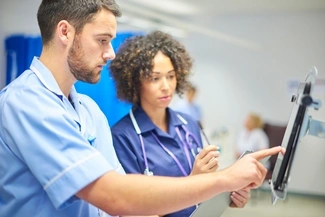Before you start any physical activity, check with your healthcare professional that it's safe for you. You can also discuss with them the level of exercise that's right for you.
Start slowly and build up gradually.
Be active at a level that's right for you.
If you have a reliever inhaler, always carry it with you and use it when you need to.
If you have a GTN spray, have this with you as well.
Be comfortable when you do these videos.
You don't need any special clothes or equipment, just some space to move around in.
Wear loose, comfortable clothing and supportive non-slip shoes, like trainers.
It's a good idea to wait around one to two hours after eating a meal or thirty minutes after eating a snack, before you start doing any physical activity and have some water close by.
If you normally use oxygen therapy when you move, then make sure to use it on your
usual setting for the exercises. Ensure you have enough oxygen to complete the session and speak to your oxygen team, if you have any concerns.
Stop exercising and get advice from your healthcare professional if you get any of these symptoms:
Chest pain or chest tightness, you feel more breathless than you usually would when being active, dizziness, feeling sick, clammy, or feeling really cold, wheezing, sore joints, or muscle weakness.
Remember, everyone is different and you need to do what's right for you.
This video is one minute and 49 seconds long and includes:
- advice on being active at a level that’s right for you
- guidance on what medicines you should keep nearby
- information about eating and drinking when you’re active
- guidance for people who use oxygen.
Before you start any physical activity check with your healthcare professional that it’s safe for you. You can also discuss the level of activity that’s right for you.
- Start slowly and build up gradually. Be active at a level that’s right for you.
- If you have a reliever inhaler, always carry it with you and use it when you need to. If you have a GTN spray, have this with you as well.
- If you normally use oxygen therapy when you move, then make sure to use it on your usual setting for the exercises. Ensure you have enough oxygen to complete the session. Speak to your oxygen team if you have any concerns.
- Wear loose, comfortable clothing and supportive non-slip shoes, like trainers.
- It’s a good idea to wait around 1 to 2 hours after eating a meal or 30 minutes after eating a snack before you start doing any physical activity.
- Have some water close by when you’re active.
Stop exercising and get advice from your healthcare professional if you get any of these symptoms:
- chest pain or chest tightness
- you feel more breathless than you usually would when being active
- dizziness
- feeling sick
- clammy or feeling really cold
- wheezing
- sore joints or muscle weakness.








